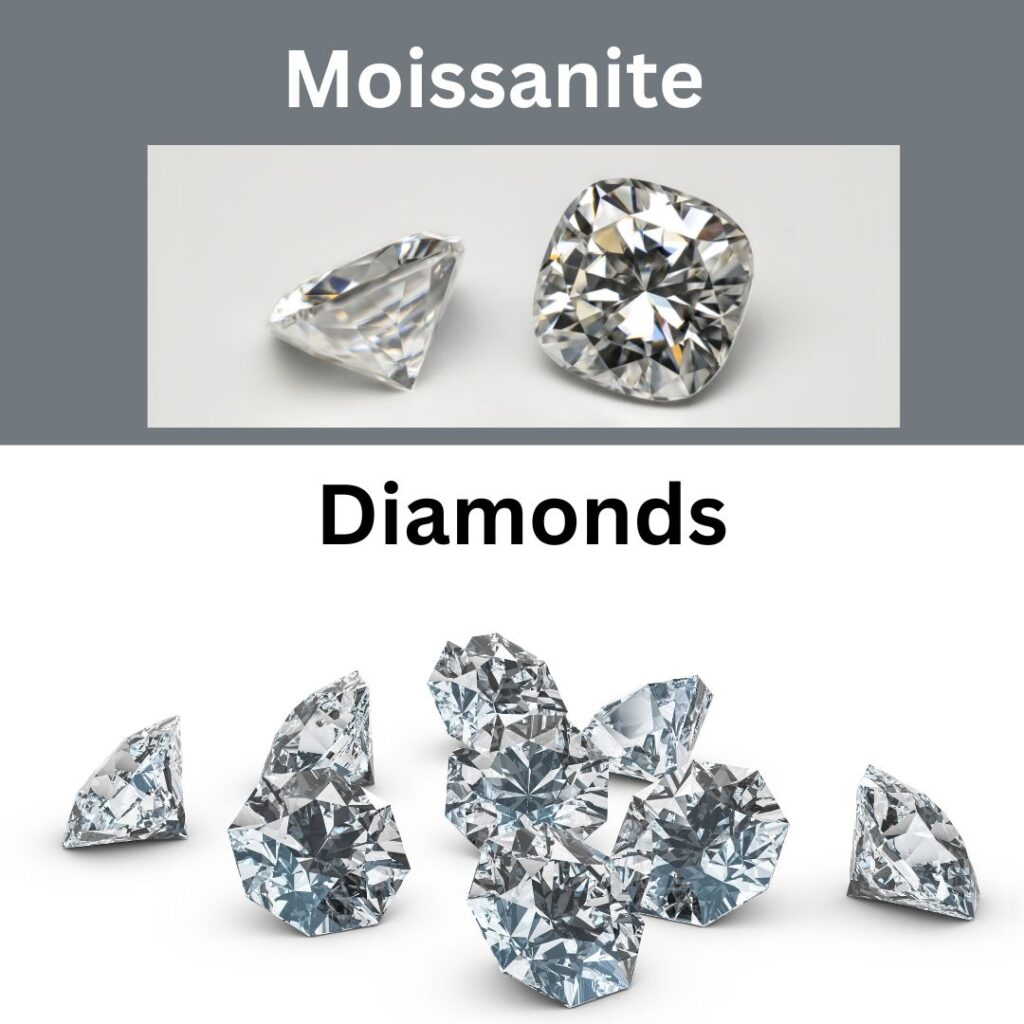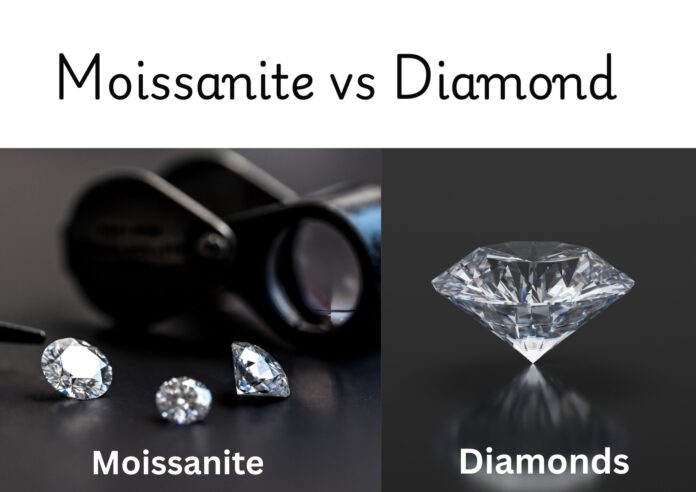Table of Contents
Introduction: Moissanite vs Diamond
Moissanite vs diamonds are both popular choices for fine jewelry, but they differ in several key ways. Moissanite, made from silicon carbide, has a higher refractive index than diamond, meaning it reflects more light and produces a brighter, more colorful sparkle. While diamonds are made of pure carbon and are the hardest natural material on Earth, moissanite is slightly less durable, scoring 9.25 on the Mohs scale compared to diamond’s perfect 10.
Moissanite is also more affordable, offering a similar appearance to diamonds at a fraction of the cost. moissanite is lab-grown, making it a more ethical and environmentally friendly option compared to diamonds, which are often mined under controversial conditions.
moissanite is a dazzling, budget-friendly alternative, while diamonds remain the timeless symbol of luxury and durability. When it comes to choosing a gemstone for an engagement ring, pendant, or any special piece of jewelry, two popular options often come up: moissanite and diamond. Both stones are beautiful and durable, but they have distinct differences in price, appearance, and other factors. This guide will help you understand these differences in simple terms, so you can make an informed decision.
What Are Moissanite and Diamonds?
Diamonds
Diamonds are natural gemstones formed deep within the Earth under high pressure and temperature. They are composed of carbon atoms arranged in a crystal structure, making them the hardest known natural material. For centuries, diamonds have been treasured and are commonly linked to opulence and enduring worth.
Moissanite
Moissanite is a gemstone made of silicon carbide, known for its remarkable brilliance and durability. In 1893, chemist Henri Moissan found it in a meteor crater, where it was first thought to be a diamond. Natural moissanite is extremely rare, and most of the moissanite used in jewelry today is lab-created. The gemstone stands out for its exceptional sparkle, as it has a higher refractive index than diamond, meaning it reflects more light and displays a rainbow-like effect, known as “fire.” rated at 9.25 on the Mohs scale, boasts exceptional durability and scratch resistance, making it an ideal choice for everyday use.
Its affordability, ethical sourcing, and environmental benefits (since it’s lab-grown) make it an attractive, budget-friendly alternative to diamonds, especially for engagement rings and other fine jewelry.
The History and Discovery of Moissanite
The history and discovery of moissanite is a fascinating journey that began over a century ago. In 1893, Henri Moissan, a French chemist, made a significant discovery while examining the remains of a meteorite that had landed in the desert close to Canyon Diablo, Arizona. Upon examining the rock, Moissan found small crystals that closely resembled diamonds. At first, he thought the crystals were diamonds because of their sparkling brilliance and resemblance.
Further analysis revealed that they were composed of silicon carbide, a substance entirely unknown at the time. Moissan named the mineral “moissanite” in his own honor. This discovery was significant, as natural moissanite is incredibly rare, only being found in a few meteorites and certain rare Earth minerals.
For many years, moissanite remained a curiosity, and it wasn’t until the late 20th century that scientists developed methods to synthetically create the gemstone in laboratories. These lab-grown moissanite now provide a stunning, ethical alternative to diamonds. Known for their exceptional brilliance, fire, and durability, moissanite stones have become popular in fine jewelry, particularly engagement rings, offering a more affordable and sustainable option compared to natural diamonds. Today, moissanite’s rich history is celebrated not only for its scientific discovery but also for its modern-day appeal as an ethical and cost-effective gemstone.
Is Moissanite Actually a Diamond?
No, moissanite is not a diamond, though they are often confused due to their similar appearance. Moissanite is a distinct gemstone made of silicon carbide, while diamonds are composed of pure carbon. The two stones differ in several important ways, including their chemical structure, optical properties, and origin.
Moissanite was first discovered in 1893 by Henri Moissan in a meteor crater and is extremely rare in nature. Almost all moissanite used in jewelry today is lab-grown. Unlike other gemstones, diamonds are created over millions of years under intense pressure and high temperatures deep within the Earth’s crust. While both gemstones are known for their brilliance, moissanite has a higher refractive index, meaning it tends to display more fire, or rainbow-like flashes, than diamonds.
Moissanite is also slightly less hard than diamonds, ranking 9.25 on the Mohs scale compared to diamonds’ perfect score of 10. Despite these differences, moissanite has become a popular and affordable alternative to diamonds, offering similar aesthetic qualities at a fraction of the price.
Moissanite vs Diamond: Essential Differences Explained
Moissanite and diamonds are both sought-after gemstones, often used in engagement rings and fine jewelry, but they differ in several significant ways. One of the primary distinctions is their composition: moissanite is made from silicon carbide, while diamonds are composed of pure carbon. This difference in structure impacts their optical properties, making moissanite sparkle more intensely. Moissanite has a higher refractive index than diamonds, which results in a brighter, more colorful flash what’s known as “fire” in gemstone terms. While diamonds tend to show more white light, moissanite reflects a wider range of colors, giving it a more rainbow-like effect.
Diamonds are the hardest natural substance, achieving a flawless score of 10 on the Mohs scale, which indicates their exceptional resistance to scratches. Moissanite, though still very durable, scores a 9.25, which makes it less scratch-resistant but still an excellent choice for everyday wear.
Another key difference is cost. Moissanite is generally much more affordable than diamonds often priced at a fraction of the cost making it a popular choice for those seeking a budget-friendly yet stunning alternative. Despite the cost difference, both stones have a long lifespan and can endure the wear and tear of daily life.

Ethical factors also influence the decision-making process. Moissanite is almost exclusively lab-grown, so it doesn’t carry the environmental and ethical concerns associated with diamond mining, such as labor exploitation or ecological damage. While many diamonds are ethically sourced, it can still be more challenging to confirm their origin, particularly with natural diamonds.
Price of Moissanite vs Diamond
A key distinction between moissanite and diamonds is their cost.
- Moissanite: A 1-carat moissanite gemstone typically costs between $300 to $600.
- Diamond: A 1-carat diamond can range from $2,000 to $20,000 or more, depending on its quality and the 4 Cs (Carat, Cut, Color, Clarity).
This price variation allows you to purchase a larger or higher-quality moissanite stone while staying within the same budget that would only afford a smaller or lower-quality diamond.
Cost of Moissanite vs Diamond
The overall cost of a piece of jewelry depends not only on the gemstone but also on the setting, metal, and craftsmanship. Since moissanite is more affordable, the total cost of a moissanite ring or pendant is generally lower than that of a diamond piece with similar design and quality.

Hardness of Moissanite vs Diamond
Hardness refers to a material’s ability to resist scratching. On the Mohs scale of mineral hardness, which measures from 1 (the softest) to 10 (the hardest):
- Diamond: Diamond achieves a flawless score of 10, establishing it as the hardest natural substance known.
- Moissanite: Scores between 9.25 and 9.5, making it the second-hardest gemstone used in jewelry.
Both types of stones are very durable and perfect for daily use. Diamonds have a slight edge in scratch resistance because of their exceptional hardness.
Diamonds vs Moissanite: Appearance and Sparkle
Both diamonds and moissanite are known for their brilliance, which is the sparkle you see when light reflects off the stone. However, they differ in how they sparkle:
- Diamonds: Reflect white light and exhibit a classic sparkle.
- Moissanite: Reflects both white and colored light, creating a rainbow-like sparkle that some people find more dazzling.
Durability and Toughness
While diamonds are harder, moissanite is known for its toughness. Toughness describes how well a material can withstand breaking or chipping. Moissanite lacks cleavage planes, which are internal weaknesses that can cause diamonds to chip under certain conditions.
This makes moissanite a durable choice for daily wear, especially for those who lead active lifestyles.
Ethical Considerations
Moissanite is typically lab-created, making it an ethical choice for those concerned about the environmental and human rights issues associated with diamond mining. Lab-created moissanite gemstones are produced in controlled environments, ensuring they are conflict-free and have a smaller environmental footprint.
Why You Should Choose Moissanite Over Diamonds
The decision between moissanite and diamond depends on your personal preferences, budget, and values. Consider the following:
- Budget: If you’re looking for a more affordable option, moissanite offers excellent value without compromising on beauty.
- Sparkle: If you prefer a gemstone with extra brilliance and a rainbow-like sparkle, moissanite might be the right choice.
- Durability: Both stones are durable, but if you’re concerned about chipping, moissanite’s toughness may be advantageous.
- Ethics: If ethical sourcing is important to you, moissanite is a lab-created gemstone that is conflict-free.
Conclusion
Both moissanite and diamonds are stunning gemstones with their unique qualities. Moissanite offers a more affordable, ethical, and equally beautiful alternative to diamonds. Grasping the variations in cost, durability, and visual appeal will help you select the gemstone that aligns perfectly with your needs and tastes. The most important thing is that your chosen gemstone reflects your personal style and values, making it a cherished symbol for years to come.
FAQs
- What’s the difference between moissanite and diamond?
Moissanite is made of silicon carbide, while diamond is pure carbon, affecting their sparkle and appearance. Moissanite tends to have more colorful flashes. - Is moissanite as hard as diamond?
No, moissanite is slightly less hard, ranking 9.25 on the Mohs scale, while diamonds score 10. Moissanite is still durable. - Does moissanite look like a diamond?
Absolutely! Moissanite tends to exhibit more colorful, rainbow-like flashes, whereas diamonds primarily reflect white light. - Is moissanite cheaper than diamonds?
Yes, moissanite is much more affordable than diamonds, offering a similar look at a lower price. - Is moissanite ethically sourced?
Yes, moissanite is typically lab-grown, making it an eco-friendly and ethical choice.
Which should I choose for an engagement ring?
It depends on your preferences moissanite offers brilliance and affordability, while diamonds are timeless and more durable.



I truly appreciate this post. I’ve been looking everywhere for this! Thank goodness I found it on Bing. You have made my day! Thanks again
I’m so glad to hear that! 😊 Thank you for your kind words, it means a lot to know the post helped you. I’m happy you found it just when you needed it!
Hello! This is my first visit to your blog! We are a collection of volunteers and starting a new project in a community in the same niche. Your blog provided us beneficial information to work on. You have done a outstanding job!
Thanks, you need my services feel free to tell me.
Some truly good posts on this internet site, regards for contribution. “Better shun the bait, than struggle in the snare.” by John Dryden.
Heya i’m for the first time here. I came across this board and I in finding It really helpful & it helped me out a lot. I am hoping to present one thing back and aid others like you aided me.
Excellent post. I was checking constantly this blog and I am impressed! Very helpful info specifically the last part 🙂 I care for such info a lot. I was seeking this certain info for a very long time. Thank you and good luck.
I like this site very much, Its a rattling nice billet to read and find info .
Really instructive and excellent body structure of written content, now that’s user pleasant (:.
Thank you for the good writeup. It in fact was a amusement account it. Look advanced to far added agreeable from you! By the way, how could we communicate?
I’ve been browsing on-line greater than three hours today, but I by no means discovered any fascinating article like yours. It?¦s beautiful price sufficient for me. In my opinion, if all webmasters and bloggers made just right content as you probably did, the internet will likely be a lot more useful than ever before.
Good info. Lucky me I reach on your website by accident, I bookmarked it.
Thanks for another informative web site. Where else could I get that type of information written in such a perfect way? I have a project that I am just now working on, and I have been on the look out for such information.
Hello there, You’ve done an excellent job. I’ll certainly digg it and personally suggest to my friends. I’m confident they’ll be benefited from this website.
Great write-up, I am regular visitor of one’s site, maintain up the nice operate, and It’s going to be a regular visitor for a long time.
Loving the info on this site, you have done great job on the blog posts.
It¦s actually a nice and helpful piece of information. I am happy that you just shared this helpful information with us. Please keep us up to date like this. Thanks for sharing.